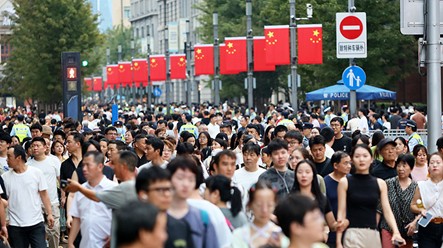
During China’s National Day and Mid-Autumn Festival in 2025, both online and offline consumption boomed again, and the holiday economy once again became a crucial window for the world to observe China’s domestic demand potential and economic vitality. A glimpse of the whole picture reveals the impressive performance of China’s “holiday economy,” fully demonstrating the strong resilience and endogenous driving force of the Chinese economy.
During the holiday season, China’s mobility showcased the strength and confidence of a major power. From October 1st to 8th (National Day and Mid-Autumn Festival holidays), the cumulative cross-regional movement of people across China was estimated at 2.432 billion, an average of 304 million per day, a year-on-year increase of 6.2%. More accessible roads and bridges, faster trains, and a more comprehensive transportation system contributed to record-breaking travel during the National Day and Mid-Autumn Festival holidays.
Service consumption is booming across China, centered around the Mid-Autumn Festival and National Day celebrations. At Songfeng Mountain Scenic Area in Heilongjiang Province, China, the autumn colors blanket the mountainside, imbued with a poetic, millennia-long atmosphere. At the foot of the mountain, the scenic area has established a leaf-making DIY area and a lacquer fan-making area, attracting numerous visitors.
New consumption scenarios, formats, and models that deeply integrate culture, sports, and tourism are becoming a new engine driving holiday consumption growth. At the Taihu Performing Arts City in Changxing, Zhejiang, China, the newly unveiled Peach Blossom Island area features 250 peach trees arranged in a staggered pattern. During the day, it evokes a tranquil idyllic atmosphere, while at night, when illuminated, it transforms into a fairyland dreamscape, leaving many visitors remarking that they felt as if they had stepped into a set of a historical drama.
“Traveling with the tournament” has also become a new way to spend the holidays. Shanghai recently launched a series of cultural and tourism promotions, including “Ticket Economy” and “Tournament Plus,” in conjunction with the tennis tournament. Tennis enthusiasts from around the world flocked to the tournament, significantly boosting retail and restaurant spending around the venues.
Reunion is the most beautiful theme of the holiday season. Data from the Chinese travel platform Qunar shows that families accounted for over 40% of travel during the holiday season, with the 23-30 age group showing the strongest consumer activity, and the 13-17 age group showing the highest growth in consumption.
Domestic tourism is booming, and inbound tourism continues to be strong. This holiday season, destinations with “Oriental aesthetics” remain popular. The “Time and Space Dialogue” cultural tourism project in Fenyi County, Xinyu, Jiangxi Province, China, transforms the ancient wisdom of “The Exploitation of the Works of Nature” into an immersive and participatory experience. A foreign tourist, Alia, was amazed by the sophistication of ancient Chinese farming techniques after personally weaving rice ropes, spinning silk, and weaving cloth in Jieqiao Ancient Village.
During the long holiday, Chinese people also chose to travel abroad, demonstrating their significant spending power. In cities like Sydney and Melbourne, Australia, Chinese can be heard everywhere. At diving resorts, such as those on the islands of the Western Pacific, the underwater world becomes crowded, creating a scene reminiscent of “dumplings.” In Switzerland, large numbers of Chinese tourists enjoyed go-karting and mountain views, resulting in traffic jams. Even Kenya, Africa, has become a popular destination for Chinese tourists this year.
According to data from the China National Immigration Administration, border inspection agencies across the country ensured the entry and exit of 16.343 million Chinese and foreign personnel during this year’s National Day and Mid-Autumn Festival holidays, with an average of 2.043 million people per day, an increase of 11.5% over the same period last year.
The long holiday also unleashed Chinese consumers’ enthusiasm. According to the Ministry of Commerce’s business data monitoring, sales of key retail and catering enterprises nationwide during the National Day and Mid-Autumn Festival holidays increased by 2.7% year-on-year on a comparable basis. From October 1st to 7th, passenger traffic and sales at the 78 pedestrian streets (commercial districts) monitored by the Ministry of Commerce increased by 8.8% and 6.0% year-on-year, respectively.
Data from major e-commerce platforms monitored by China’s Ministry of Commerce shows that sales of green and organic food increased by 27.9% year-on-year during the holiday season, smart home products by 14.3%, and trendy Chinese clothing by 14.1%. Low-fat and low-sugar mooncakes were also popular with consumers.
Green, smart, and trendy consumer spending dominated this holiday season. Platform data shows a surge in interest for smarter AI-powered home appliances, with demand surging for smart air conditioners that understand local dialects, ovens with one-click recipe searches, and multi-drum washing and shoe washers. Furthermore, home appliance consumption in counties accelerated, with dishwashers, water purifiers, and dryers becoming the “new three big appliances” in demand. Experts from the Chinese Academy of Social Sciences believe this demonstrates a shift in consumer spending from “price/performance” to “quality/price.”
From the tourism market to the consumer market, the continued growth of the “Golden Week Economy” in 2025 once again demonstrated to the world the robust vitality of the Chinese economy. As World Bank President David Malpass said, “China’s economic growth and policy support have a significant impact on the global economic recovery.” Looking ahead, we have reason to believe that with the further opening and upgrading of the Chinese market, China’s consumer market will continue to unleash unprecedented vitality, driving sustained economic development both domestically and internationally, and making a positive contribution to global economic recovery.


